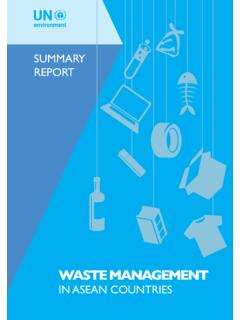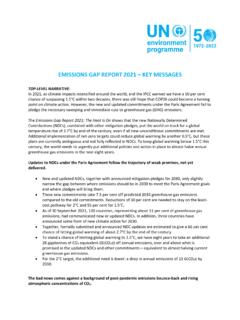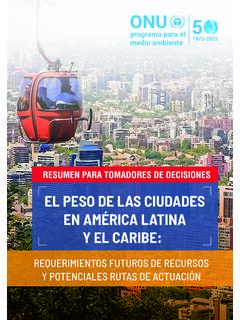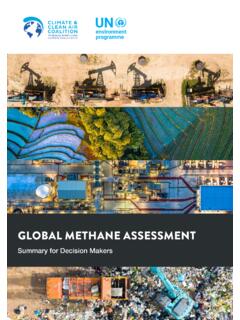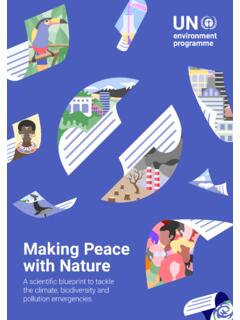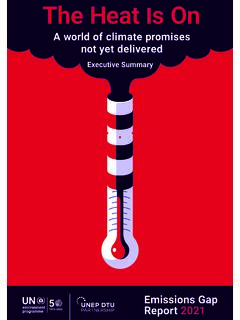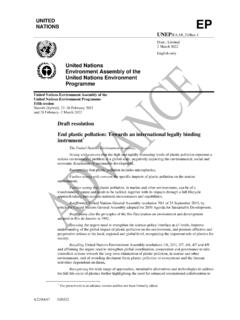Transcription of SINGLE-USE PLASTICS - wedocs.unep.org
1 SINGLE-USE . PLASTICS . A Roadmap for Sustainability (rev. 1). Copyright United Nations Environment Programme, 2018. Reproduction This publication may be reproduced in whole or in part and in any form for educational or non-profit purposes without special permission from the copyright holder, provided acknowledgement of the source is made. The United Nations Environment Programme would appreciate receiving a copy of any publication that uses this publication as a source. No use of this publication may be made for resale or for any other commercial purpose whatsoever without prior permission in writing from the United Nations Environment Programme. Disclaimer The designations employed and the presentation of the material in this publication do not imply the expression of any opinion whatsoever on the part of the United Nations Environment Programme concerning the legal status of any country, territory, city or area or of its authorities, or concerning delimitation of its frontiers or boundaries.
2 Moreover, the views expressed do not necessarily represent the decision or the stated policy of the United Nations Environment Programme, nor does citing of trade names or commercial processes constitute endorsement. Mention of a commercial company or product in this publication does not imply endorsement by the United Nations Environment Programme. ISBN: 978-92-807-3705-9. DTI/2179/JP. Suggested citation: UNEP (2018). SINGLE-USE PLASTICS : A Roadmap for Sustainability Credits Photos, and illustrations as specified. The International Environmental Technology Centre works with developing countries to implement sustainable solutions to environmental challenges, with focus on holistic waste management.
3 UNEP promotes environmentally sound practices globally and in its own activities. This publication will be Cover photo: londonista_ available as an electronic document. Our distribution policy aims to reduce UNEP's carbon footprint. Foreword Plastic is a miracle material. Thanks to PLASTICS , countless lives have been saved in the health sector, the growth of clean energy from wind turbines and solar panels has been greatly facilitated, and safe food storage has been revolutionized. But what makes plastic so convenient in our day-to-day lives it's cheap also makes it ubiquitous, resulting in one of our planet's greatest environmental challenges. Our oceans have been used as a dumping ground, choking marine life and transforming some marine areas into a plastic soup.
4 In cities around the world, plastic waste clogs drains, causing floods and breeding disease. Consumed by livestock, it also finds its way into the food chain. Plastic packaging accounts for nearly half of all plastic waste globally, and much of it is thrown away within just a few minutes of its first use. Much plastic may be SINGLE-USE , but that does not mean it is easily disposable. When discarded in landfills or in the environment, plastic can take up to a thousand years to decompose. The good news is that a growing number of governments are taking action and demonstrating that all nations, whether rich or poor, can become global environmental leaders. Rwanda, a pioneer in banning SINGLE-USE plastic bags, is now one of the cleanest nations on earth.
5 Kenya has followed suit, helping clear its iconic national parks and save its cows from an unhealthy diet. Learning from the experience of countries that have introduced bans and regulations on SINGLE-USE PLASTICS , this assessment analyses what has worked well, what hasn't, and why. The report is therefore a tool for policymakers who intend to introduce measures to regulate the production and use of disposable PLASTICS . The assessment shows that action can be painless and profitable . with huge gains for people and the planet that help avert the costly downstream costs of pollution. In addition, action will drive the kind of innovation that will underpin the future global economy we need.
6 Plastic isn't the problem. It's what we do with it. And that means the onus is on us to be far smarter in how we use this miracle material. Erik Solheim Head of UN Environment i SINGLE-USE PLASTICS : A Roadmap for Sustainability Acknowledgements Lead author and project management Claudia Giacovelli (Associate Programme Officer, UN. Environment-IETC). Research and drafting support Anna Zamparo (UN Environment-IETC Intern), Andrea Wehrli (Mercator Fellow at IETC). Supervisor Keith Alverson (Director, UN Environment-IETC). Data and case studies contributors Joi Danielson (Vital Ocean); Liu Jinghao (Environmental Sanitation Engineering Technology Research Center of MOHURD, China); Yoichi Kodera (Japan National Institute of Advanced Industrial Science & Technology); Jordi Pon (UN Environment).
7 Marc Nyhan (Ireland citizen); Thibault Mutabazi (Rwanda citizen); Michael Raymond (Aruba Waste Management Services, Serlimar); Spurgeon Miller Molina (Mayor of Guanaja, Honduras). Technical Review Committee Bettina Lorz (European Commission); Dominic Hogg (Eumonia Research & Consulting); Joi Danielson (Vital Ocean); Keith Alverson (UN Environment);. Linda Godfrey (Council for Scientific and Industrial Research, South Africa); Yoichi Kodera (Japan National Institute of Advanced Industrial Science &. Technology). Production project team Claudia Giacovelli (UN Environment -IETC); Tomoya Motoda (Global Environment Centre), Akiko Doi (Global Environment Centre), Miki Minamino (Global Environment Centre).
8 Copy editor Tara Cannon Illustrations and design Lowil Fred Espada This assessment has been realized with the kind financial contribution of the Government of Norway. ii Foreword i Chapter 3. Acknowledgements ii Table of Contents iii Acronyms v Actions to minimize plastic bags and Styrofoam products 17. Executive summary vi Waste management Chapter system 2. improvements 18. Promotion of eco-friendly alternatives 19. Chapter Social awareness 1. and public pressure 19. Problematic SINGLE-USE Voluntary reduction PLASTICS 9 strategies and agreements 19. Plastic bags and foamed plastic Policy instruments 23. The plastic context 1 products 11 Global trends 23.
9 Definitions 2 Environmental Regional, national impacts 12 and local trends 24. Production 2. Health and Social Countries with Consumption 2 impacts 14 policies on plastic End of life 6 Economic impacts 15 bags and Styrofoam 27. Table of Contents Selected case studies 45. Europe 46. Ireland: Levy on consumers 46. Austria: Voluntary agreements 48. Africa 49. Rwanda: Total ban 49. Chapter South Africa: Combined ban and levy on retailers . Kenya: Punitive total ban . 50. 52. 5. Asia 53. China: National and provincial Chapter 4. policies 53 Conclusions 63. Bangladesh: Social pressure Bans and levies 65. and disaster management 55. India: Public engagement 56 Other possible actions 65.
10 America 57. Roadmap for New York City: Styrofoam ban 57. policymakers 66. Costa Rica: Total SINGLE-USE plastic ban 58. The Caribbean region 59 References 74. iii SINGLE-USE PLASTICS : A Roadmap for Sustainability List of Boxes Box 1. Plastic recycling market: China 6. Box 2. Reducing PET bottle litter 11. Box 3. Biodiversity loss and food chain contamination 13. Box 4. Biodegradable plastic: The unintended consequences 14. Box 5. The controversy of reusable bags 20. Box 6. The 'ban on banning'' 23. Box 7. Food for thought 64. List of Figures Figure The two main categories of PLASTICS and their SINGLE-USE applications 3. Figure Global plastic production by industrial sector, 2015 4.
